Abstract
The aim of the present study was to determine if the measurement of the slope of teh histamine dose-response curve (bronchial reactivity) could provide useful information on the clinical state of asthma. Fifteen adult asthmatic subjects were studied twice at an interval of one year. Their clinical state was assessed by comparing their respiratory symptoms, need for medication, and FEV1 on both visits. Histamine inhalation challenges were carried out in a similar manner both times using a standardised procedure. PC20FEV1 (the histamine concentration causing a 20% fall of FEV1) and reactivity were obtained from the dose-response curves. AS others have shown, we found that PC20FEV1 reflects clinical state. Indeed, changes of PC20FEV1 greater than a single two-fold dilution of histamine were shown by five of six patients who were not in a steady clinical state, and by none of the nine patients who were. Changes of PC20FEV1 were significantly (p less than 0.005) more important in those who were not in a steady state in comparison with those who were. The reproducibility of reactivity was slightly better in those individuals who were in a steady clinical state as compared with those who were not. Nevertheless, changes in reactivity did not allow significant differentiation between the two groups of subjects. We conclude that PC20FEV1 is a more helpful index than reactivity in characterising the clinical state of asthmatics.
Full text
PDF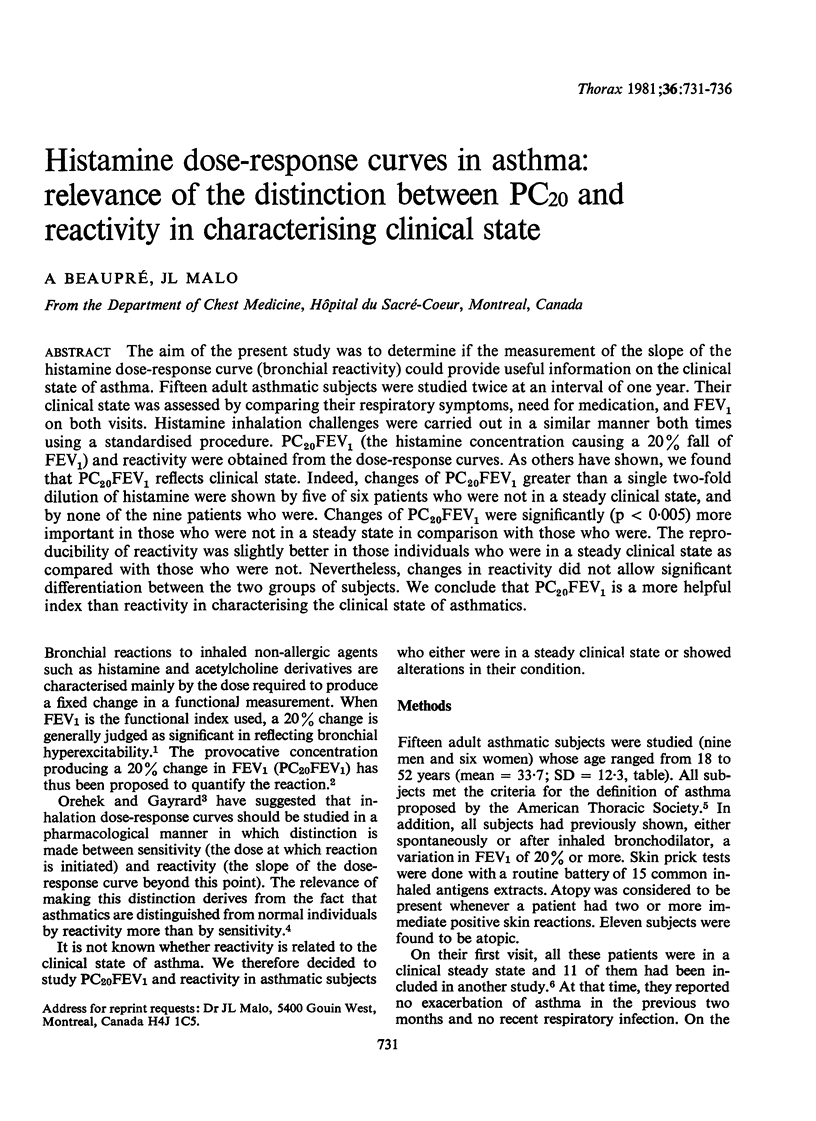
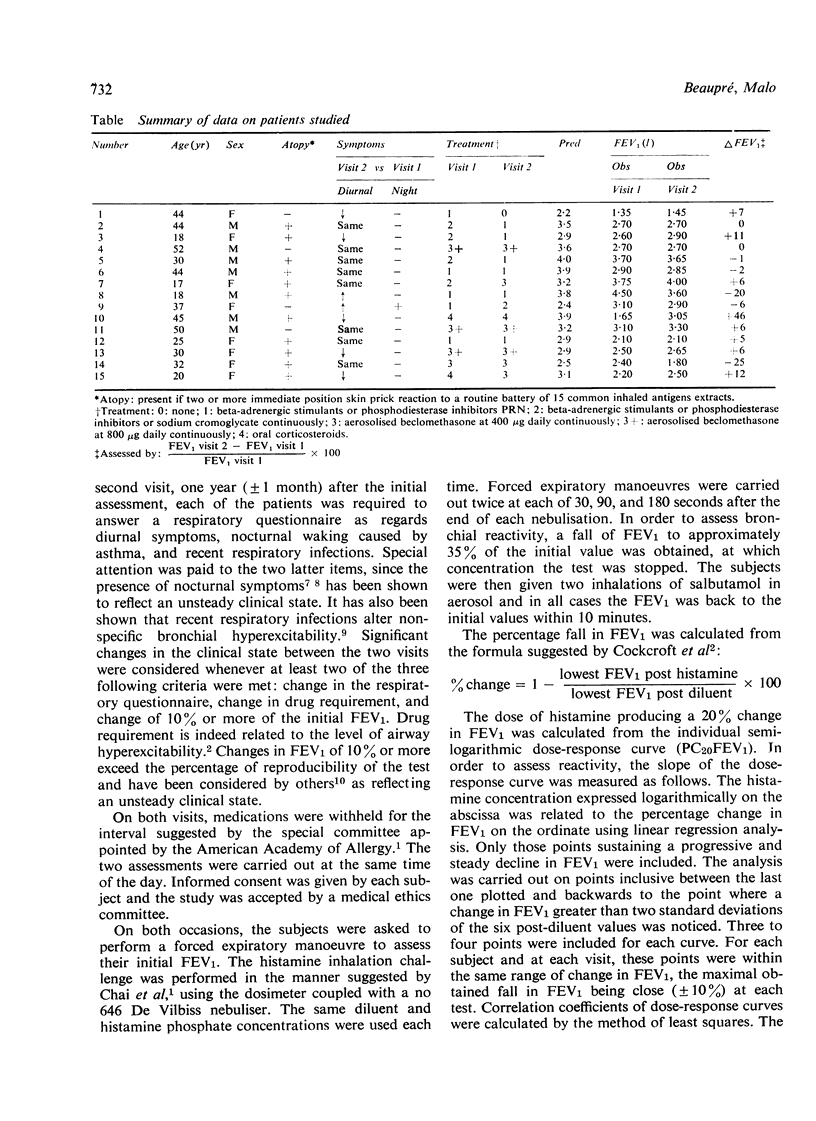
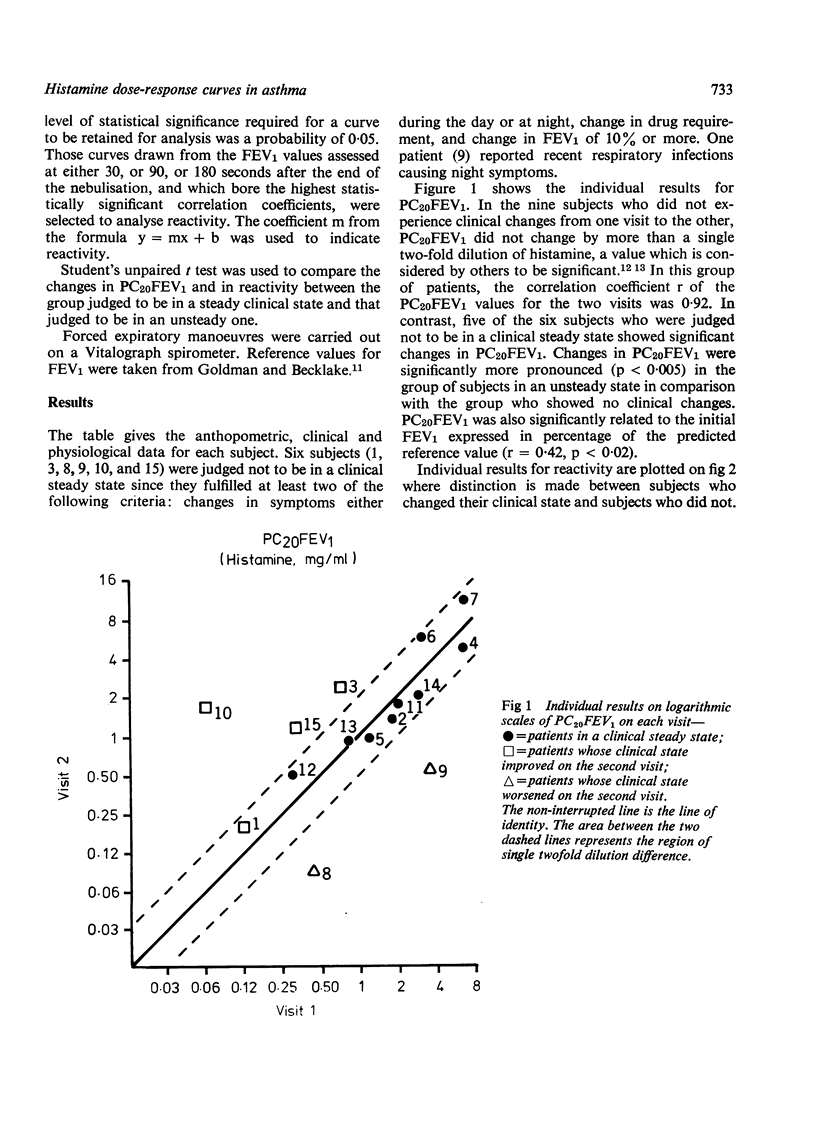
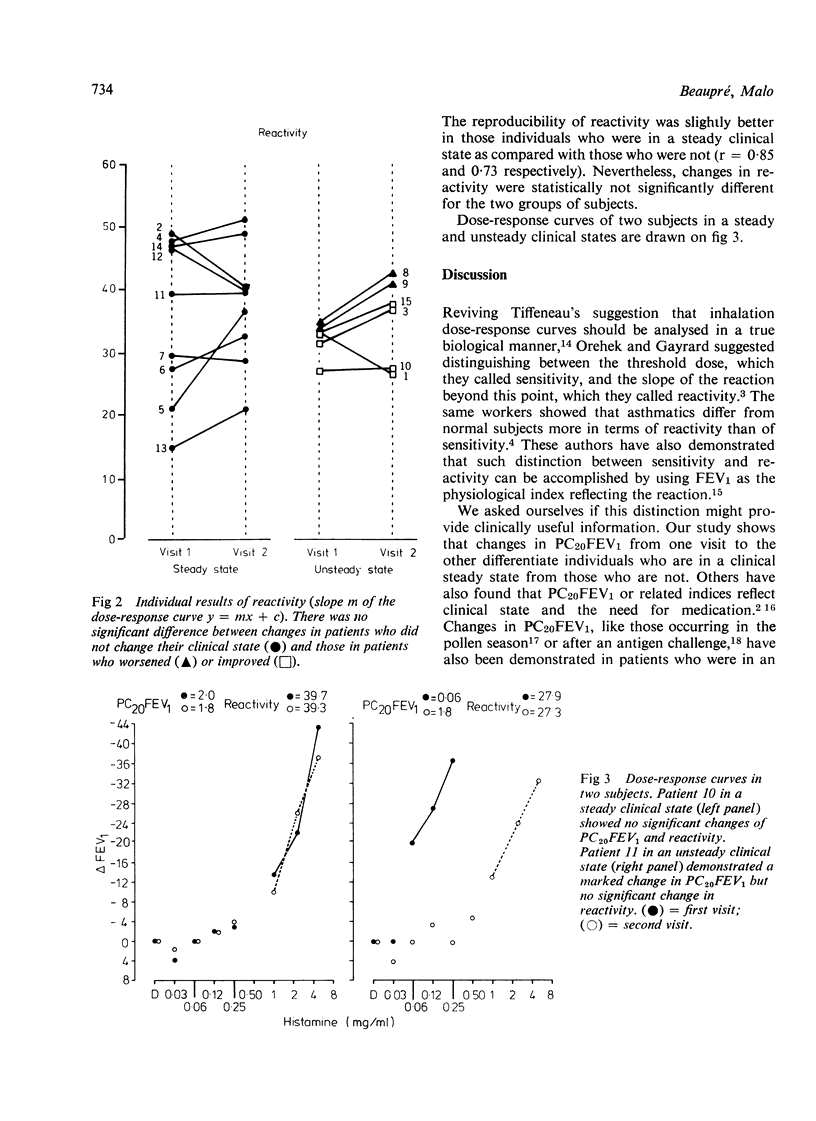
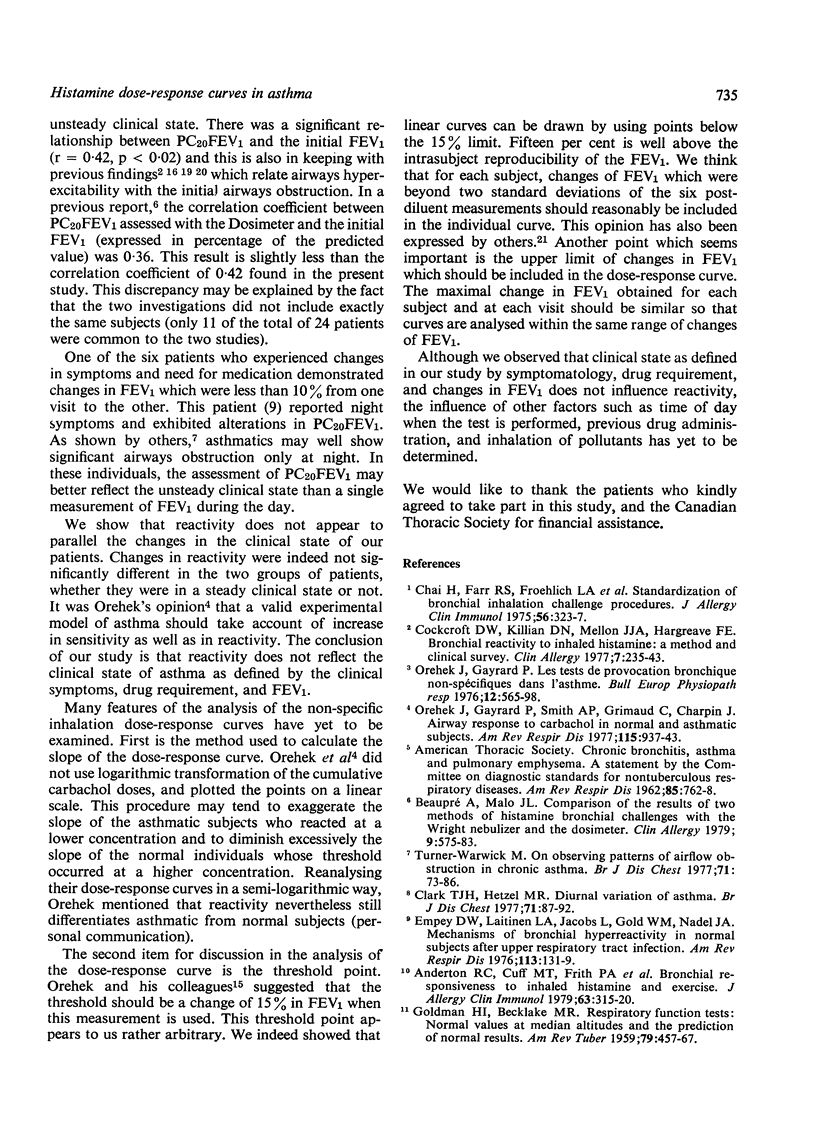
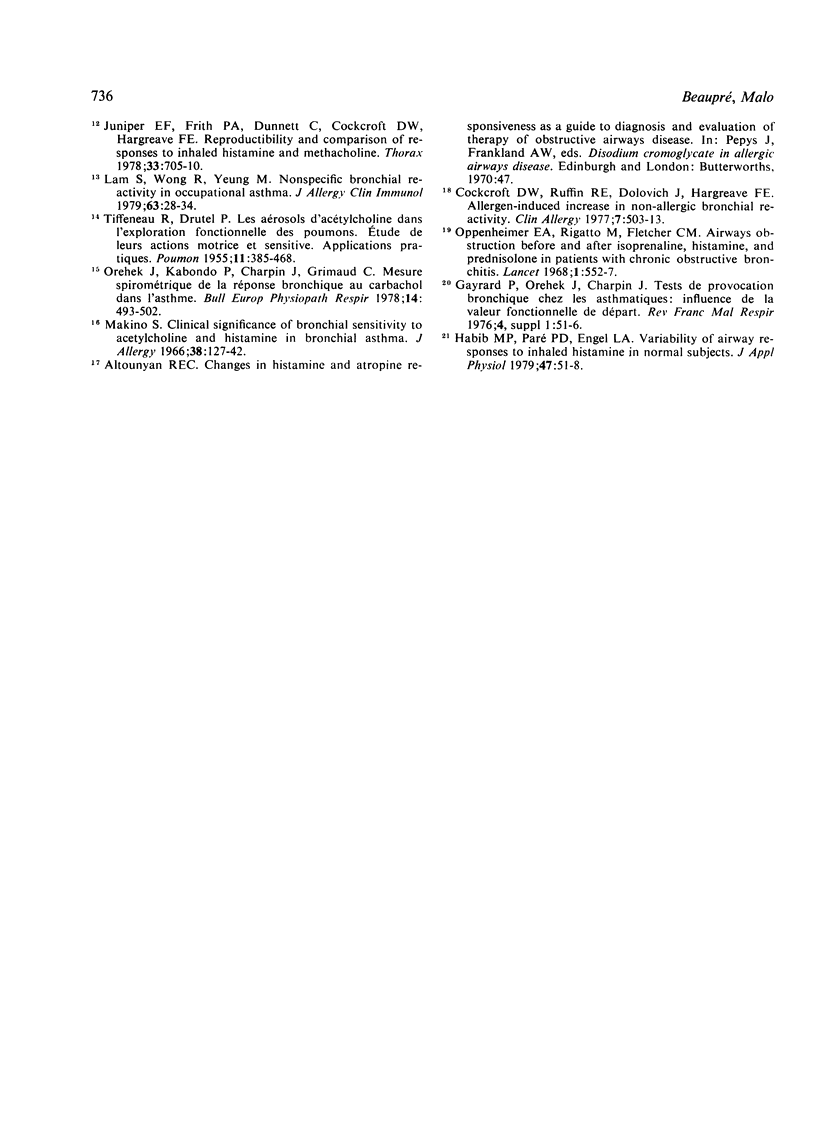
Selected References
These references are in PubMed. This may not be the complete list of references from this article.
- Anderton R. C., Cuff M. T., Frith P. A., Cockcroft D. W., Morse J. L., Jones N. L., Hargreave F. E. Bronchial responsiveness to inhaled histamine and exercise. J Allergy Clin Immunol. 1979 May;63(5):315–320. doi: 10.1016/0091-6749(79)90125-8. [DOI] [PubMed] [Google Scholar]
- Beaupré A., Malo J. L. Comparison of histamine bronchial challenges with the Wright nebulizer and the dosimeter. Clin Allergy. 1979 Nov;9(6):575–583. doi: 10.1111/j.1365-2222.1979.tb00482.x. [DOI] [PubMed] [Google Scholar]
- Chai H., Farr R. S., Froehlich L. A., Mathison D. A., McLean J. A., Rosenthal R. R., Sheffer A. L., Spector S. L., Townley R. G. Standardization of bronchial inhalation challenge procedures. J Allergy Clin Immunol. 1975 Oct;56(4):323–327. doi: 10.1016/0091-6749(75)90107-4. [DOI] [PubMed] [Google Scholar]
- Clark T. J., Hetzel M. R. Diurnal variation of asthma. Br J Dis Chest. 1977 Apr;71(2):87–92. doi: 10.1016/0007-0971(77)90087-0. [DOI] [PubMed] [Google Scholar]
- Cockcroft D. W., Killian D. N., Mellon J. J., Hargreave F. E. Bronchial reactivity to inhaled histamine: a method and clinical survey. Clin Allergy. 1977 May;7(3):235–243. doi: 10.1111/j.1365-2222.1977.tb01448.x. [DOI] [PubMed] [Google Scholar]
- Cockcroft D. W., Ruffin R. E., Dolovich J., Hargreave F. E. Allergen-induced increase in non-allergic bronchial reactivity. Clin Allergy. 1977 Nov;7(6):503–513. doi: 10.1111/j.1365-2222.1977.tb01481.x. [DOI] [PubMed] [Google Scholar]
- Empey D. W., Laitinen L. A., Jacobs L., Gold W. M., Nadel J. A. Mechanisms of bronchial hyperreactivity in normal subjects after upper respiratory tract infection. Am Rev Respir Dis. 1976 Feb;113(2):131–139. doi: 10.1164/arrd.1976.113.2.131. [DOI] [PubMed] [Google Scholar]
- GOLDMAN H. I., BECKLAKE M. R. Respiratory function tests; normal values at median altitudes and the prediction of normal results. Am Rev Tuberc. 1959 Apr;79(4):457–467. doi: 10.1164/artpd.1959.79.4.457. [DOI] [PubMed] [Google Scholar]
- Juniper E. F., Frith P. A., Dunnett C., Cockcroft D. W., Hargreave F. E. Reproducibility and comparison of responses to inhaled histamine and methacholine. Thorax. 1978 Dec;33(6):705–710. doi: 10.1136/thx.33.6.705. [DOI] [PMC free article] [PubMed] [Google Scholar]
- Lam S., Wong R., Yeung M. Nonspecific bronchial reactivity in occupational asthma. J Allergy Clin Immunol. 1979 Jan;63(1):28–34. doi: 10.1016/0091-6749(79)90158-1. [DOI] [PubMed] [Google Scholar]
- Makino S. Clinical significance of bronchial sensitivity to acetylcholine and histamine in bronchial asthma. J Allergy. 1966 Sep;38(3):127–142. doi: 10.1016/0021-8707(66)90036-0. [DOI] [PubMed] [Google Scholar]
- Oppenheimer E. A., Rigatto M., Fletcher C. M. Airways obstruction before and after isoprenaline, histamine, and presnisolone in patients with chronic obstructive bronchitis. Lancet. 1968 Mar 16;1(7542):552–557. doi: 10.1016/s0140-6736(68)92829-8. [DOI] [PubMed] [Google Scholar]
- Orehek J., Gayrard P. Les tests de provocation bronchique non-spécifiques dans l'asthme. Bull Eur Physiopathol Respir. 1976 Jul-Aug;12(4):565–598. [PubMed] [Google Scholar]
- Orehek J., Gayrard P., Smith A. P., Grimaud C., Charpin J. Airway response to carbachol in normal and asthmatic subjects: distinction between bronchial sensitivity and reactivity. Am Rev Respir Dis. 1977 Jun;115(6):937–943. doi: 10.1164/arrd.1977.115.6.937. [DOI] [PubMed] [Google Scholar]
- Orehek J., Kabondo P., Charpin J., Grimaud C. Mesure spirométrique de la réponse bronchique au carbachol dans l'asthme. Bull Eur Physiopathol Respir. 1978 Sep-Oct;14(5):493–502. [PubMed] [Google Scholar]
- TIFFENEAU R., DRUTEL P. Les aérosols d'acetylcholine dans l'exploration fonctionnelle des poumons; étude de leurs actions motrice et sensitiva applications pratiques. Poumon Coeur. 1955 May;11(5):385–468. [PubMed] [Google Scholar]
- Turner-Warwick M. On observing patterns of airflow obstruction in chronic asthma. Br J Dis Chest. 1977 Apr;71(2):73–86. doi: 10.1016/0007-0971(77)90086-9. [DOI] [PubMed] [Google Scholar]


